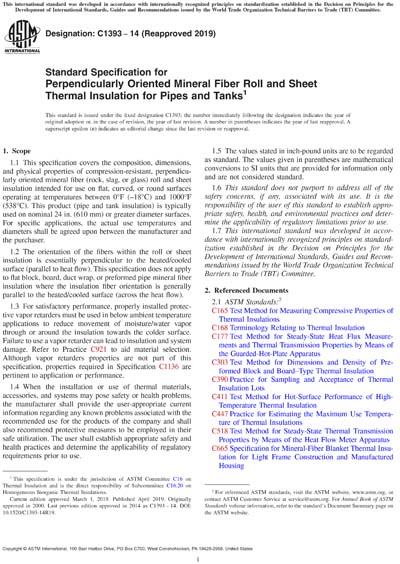Historical
ASTM C1393-14(2019)
Standard Specification for Perpendicularly Oriented Mineral Fiber Roll and Sheet Thermal Insulation for Pipes and Tanks
1.1 This specification covers the composition, dimensions, and physical properties of compression-resistant, perpendicularly oriented mineral fiber (rock, slag, or glass) roll and sheet insulation intended for use on flat, curved, or round surfaces operating at temperatures between 0°F (–18°C) and 1000°F (538°C). This product (pipe and tank insulation) is typically used on nominal 24 in. (610 mm) or greater diameter surfaces. For specific applications, the actual use temperatures and diameters shall be agreed upon between the manufacturer and the purchaser.
1.2 The orientation of the fibers within the roll or sheet insulation is essentially perpendicular to the heated/cooled surface (parallel to heat flow). This specification does not apply to flat block, board, duct wrap, or preformed pipe mineral fiber insulation where the insulation fiber orientation is generally parallel to the heated/cooled surface (across the heat flow).
1.3 For satisfactory performance, properly installed protective vapor retarders must be used in below ambient temperature applications to reduce movement of moisture/water vapor through or around the insulation towards the colder surface. Failure to use a vapor retarder can lead to insulation and system damage. Refer to Practice C921 to aid material selection. Although vapor retarders properties are not part of this specification, properties required in Specification C1136 are pertinent to application or performance.
1.4 When the installation or use of thermal materials, accessories, and systems may pose safety or health problems, the manufacturer shall provide the user-appropriate current information regarding any known problems associated with the recommended use for the products of the company and shall also recommend protective measures to be employed in their safe utilization. The user shall establish appropriate safety and health practices and determine the applicability of regulatory requirements prior to use.
1.5 The values stated in inch-pound units are to be regarded as standard. The values given in parentheses are mathematical conversions to SI units that are provided for information only and are not considered standard.
1.6 This standard does not purport to address all of the safety concerns, if any, associated with its use. It is the responsibility of the user of this standard to establish appropriate safety, health, and environmental practices and determine the applicability of regulatory limitations prior to use.
1.7 This international standard was developed in accordance with internationally recognized principles on standardization established in the Decision on Principles for the Development of International Standards, Guides and Recommendations issued by the World Trade Organization Technical Barriers to Trade (TBT) Committee.
Content Provider
ASTM International [astm]






